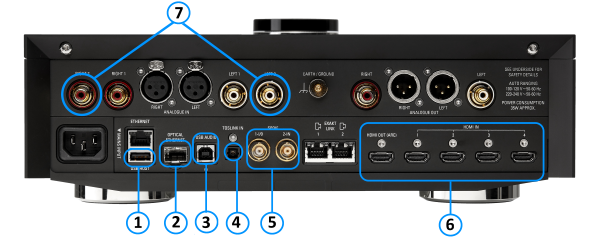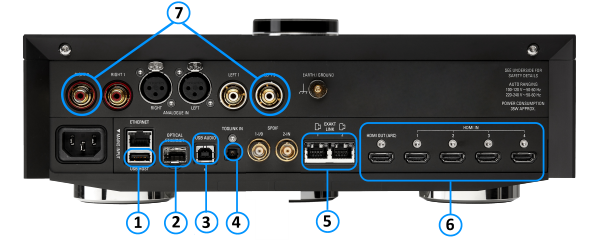Difference between revisions of "Template:FAQ:KDSM/3 differences"
m (→What is the difference between Klimax DSM (2020 variant) and earlier versions?) |
m |
||
| (2 intermediate revisions by the same user not shown) | |||
| Line 5: | Line 5: | ||
::::• This clock is used as the Exakt <u><b>master clock</b></u> and is distributed to all Exakt devices in the system | ::::• This clock is used as the Exakt <u><b>master clock</b></u> and is distributed to all Exakt devices in the system | ||
::::• Improving the clock in the Klimax DSM (AV / Music / Hub) improves the performance of all Exakt devices in the system | ::::• Improving the clock in the Klimax DSM (AV / Music / Hub) improves the performance of all Exakt devices in the system | ||
| − | ::::• Klimax Exakt DSM has 4off Exakt sockets, the Klimax DSM HUB only has 2off. | + | ::::• Klimax Exakt DSM has <b>4off</b> Exakt sockets, the Klimax DSM HUB only has <b>2off</b>. |
;:Analogue Inputs | ;:Analogue Inputs | ||
| Line 30: | Line 30: | ||
;:HDMI | ;:HDMI | ||
::::• [[HDMI#HDMI_eARC|<u>HDMI eARC</u>]] support | ::::• [[HDMI#HDMI_eARC|<u>HDMI eARC</u>]] support | ||
| + | |||
| + | |||
| + | |||
| + | ;<u>Differences between the previous version of Klimax DSM and Klimax System Hub</u> | ||
| + | ;:Klimax DSM/3 and Klimax DSM/2 (2016-2018 variant) | ||
| + | ::{{:Difference:KDSM-3 to KDSM-2}} | ||
| + | <br><br> | ||
| + | |||
| + | |||
| + | ;:Klimax DSM/3 and Klimax Exakt DSM/Klimax System Hub | ||
| + | ::{{:Difference:KDSM-3 to KEDSM-0}} | ||
Latest revision as of 10:32, 18 June 2021
What is the difference between Klimax DSM (2020 variant) and earlier versions?
-
- • Ultra-low jitter clock with improved clock distribution circuitry and new low-noise power supply
- • This clock is used as the Exakt master clock and is distributed to all Exakt devices in the system
- • Improving the clock in the Klimax DSM (AV / Music / Hub) improves the performance of all Exakt devices in the system
- • Klimax Exakt DSM has 4off Exakt sockets, the Klimax DSM HUB only has 2off.
- Analogue Inputs
-
- • Brand new, high-performance ADC (analogue to digital converter) which now has its own circuit board and dedicated power supply
- • New design has lower noise and lower distortion which benefits all analogue sources
- Digital Inputs
-
- • New Linn-designed SPDIF receiver implemented in an FPGA
- • Improved clock recovery algorithm for reduced jitter
- • SPDIF inputs support up to 192kHz/24-bit audio
- • One SPDIF digital input can be configured as an output - This is also possible in the Klimax DSM/2 (2016/208 variant)
- • The addition of a USB (type B) input allows connection to a computer as an audio device
- • USB input supports up to 384kHz/24-bit audio
- Streaming
-
- • 384kHz/24-bit streaming support
- • DSD256 audio format support
- Connectivity
-
- • The optical Ethernet connection improves audio performance by providing complete isolation from noisy network components
- • WiFi and Bluetooth (4.2) connectivity
- • Audio can be streamed from devices such as mobile phones, Alexa, Google Home
- HDMI
-
- • HDMI eARC support
- Differences between the previous version of Klimax DSM and Klimax System Hub
- Klimax DSM/3 and Klimax DSM/2 (2016-2018 variant)

- Addition of Service-Use socket
- Addition of Optical Ethernet connection
- Addition of USB socket for connection to PC/MAC
- Removal of TOSLINK socket from 2off to 1off
- Addition of another SPDIF Input. (One socket can still be configured as a digital Input or Output)
- Addition of another HDMI-2 input
- Addition of third analogue input. (RCA type)
- Klimax DSM/3 and Klimax Exakt DSM/Klimax System Hub

- Addition of Service-Use socket
- Addition of Optical Ethernet connection
- Addition of USB socket for connection to PC/MAC
- Removal of TOSLINK socket from 2off to 1off.
- Removal of 2off EXAKT-LINK sockets from 4off to 2off.
- Addition of another HDMI-2 input
- Addition of third analogue input. (RCA type)